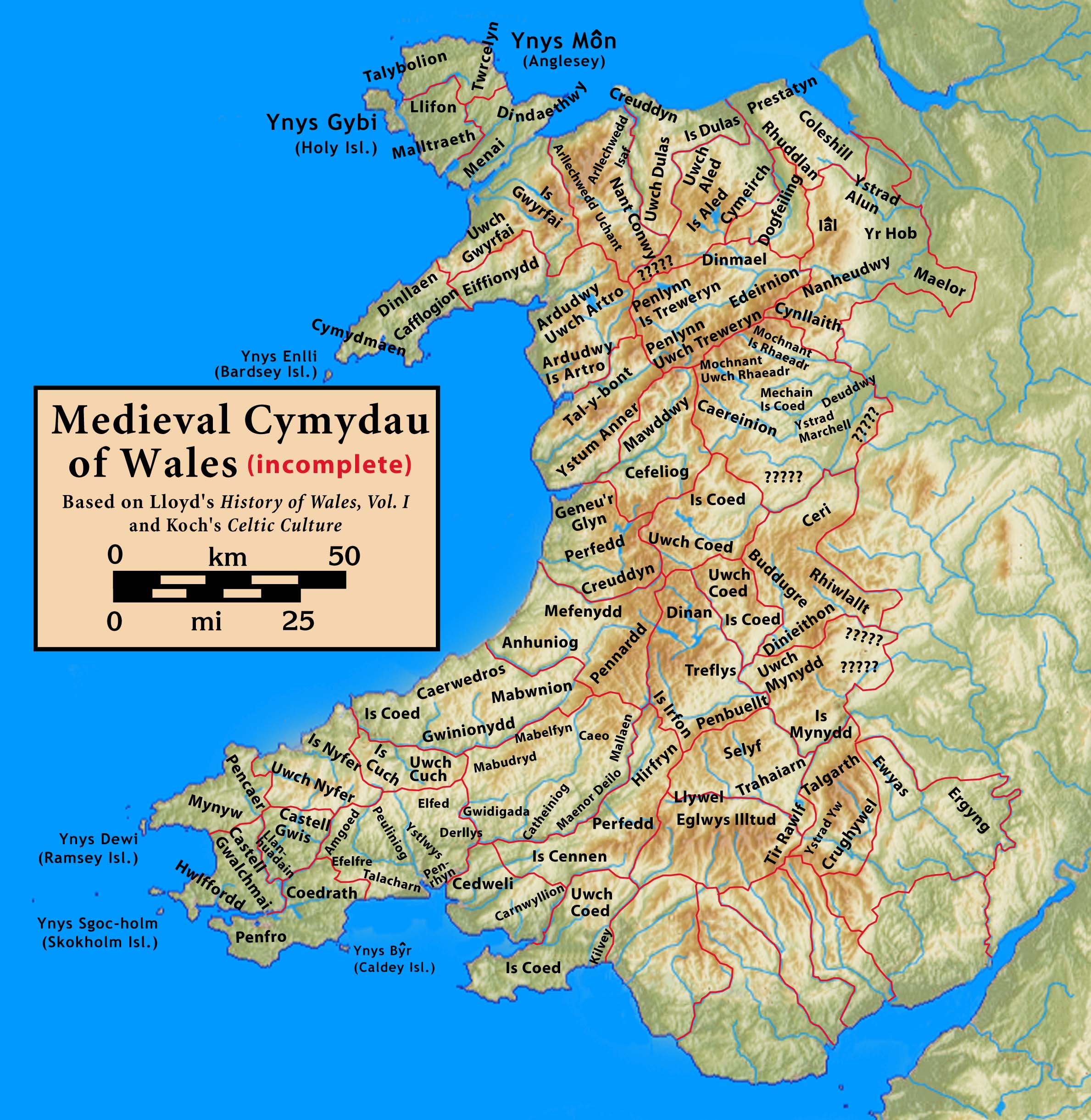Deuddwr on:
[Wikipedia]
[Google]
[Amazon]

 Deuddwr (; en,
Deuddwr (; en,

 Deuddwr (; en,
Deuddwr (; en, Confluence
In geography, a confluence (also: ''conflux'') occurs where two or more flowing bodies of water join to form a single channel. A confluence can occur in several configurations: at the point where a tributary joins a larger river (main stem); o ...
, literally: two waters) was a medieval commote
A commote (Welsh ''cwmwd'', sometimes spelt in older documents as ''cymwd'', plural ''cymydau'', less frequently ''cymydoedd'')''Geiriadur Prifysgol Cymru'' (University of Wales Dictionary), p. 643 was a secular division of land in Medieval Wales ...
(''cwmwd'') in the cantref
A cantref ( ; ; plural cantrefi or cantrefs; also rendered as ''cantred'') was a medieval Welsh land division, particularly important in the administration of Welsh law.
Description
Land in medieval Wales was divided into ''cantrefi'', which were ...
of Ystlyg
Ystlyg ( en, possibly curve or open country) was a medieval cantref in the Kingdom of Powys. It lay at the east of the kingdom on the border with England. It consisted of the commotes (''cymydau'') of Deuddwr in the north, Ystrad Marchell in the ce ...
in the Kingdom of Powys
The Kingdom of Powys ( cy, Teyrnas Powys; la, Regnum Poysiae) was a Welsh successor state, petty kingdom and principality that emerged during the Middle Ages following the end of Roman rule in Britain. It very roughly covered the northern ...
.
It lay at the east of the kingdom, bordering England to the north, the cantref of Mechain
Mechain was a medieval cantref in the Kingdom of Powys. This cantref has also been referred to as Y Fyrnwy (''Vyrnwy''). Mechain may owe its name to the River Cain which flows through it on its way to join the River Vyrnwy; 'Me' or 'Mach' (c.f. ...
to the north-west and, within Ystlyg, the commotes of Ystrad Marchell
Ystrad Marchell sometimes Strad Marchell ( en, Vale of Marchell) was a medieval commote (''cwmwd'') in the cantref of Ystlyg in the Kingdom of Powys. It roughly coincides with the parish of Welshpool.
It lay at the east of the kingdom, bordering ...
to the south and Y Gorddwr Y Gorddwr (or Corddwr) ( en, The Upper Water) was a medieval commote (''cwmwd'') in the cantref of Ystlyg in the Kingdom of Powys. It was on the eastern side of the River Severn bordering England, on the west it was bordered by two of the other com ...
to the east. It is also between the River Vyrnwy
The River Vyrnwy ( cy, Afon Efyrnwy, ) is a river which flows through northern Powys, Wales, and Shropshire, England. The name derives from Severn, the river of which it is a tributary.
Course
The river used to be sourced from the many rivers a ...
in the north-east and the River Severn
, name_etymology =
, image = SevernFromCastleCB.JPG
, image_size = 288
, image_caption = The river seen from Shrewsbury Castle
, map = RiverSevernMap.jpg
, map_size = 288
, map_c ...
in the south-east, they meet at the east of the commote, hence its name. The cantref of Ystlyg (excluding Y Gorddwr) corresponds to the later hundred
100 or one hundred (Roman numeral: C) is the natural number following 99 and preceding 101.
In medieval contexts, it may be described as the short hundred or five score in order to differentiate the English and Germanic use of "hundred" to de ...
of Deuddwr. The name of this hundred has been corrupted to Deythur or Deytheur. The name occurs in modern placenames, e.g. the parish of Llansantffraid Deythur and the village of Deuddwr south-east of Llansantffraid-ym-Mechain
Llansantffraid-ym-Mechain is a large village (in the community (Wales), community of Llansantffraid) in Powys, Mid Wales, close to the border with Shropshire in England, about south west of Oswestry and north of Welshpool. It is on the A495 roa ...
.
Together with Llannerch Hudol and Ystrad Marchell it formed the ''Teirswydd'' ("three commotes") which were among the lands restored into the possession of Gruffydd ap Gwenwynwyn
Gruffydd ap Gwenwynwyn (died c. 1286) was a Welsh king who was lord of the part of Powys known as Powys Wenwynwyn and sided with Edward I in his conquest of Wales of 1277 to 1283.
Gruffydd was the son of Gwenwynwyn and Margaret Corbet. He was st ...
in return for his homage and fealty
An oath of fealty, from the Latin ''fidelitas'' (faithfulness), is a pledge of allegiance of one person to another.
Definition
In medieval Europe, the swearing of fealty took the form of an oath made by a vassal, or subordinate, to his lord. "Fea ...
by Llywelyn ap Gruffudd
Llywelyn ap Gruffudd (c. 1223 – 11 December 1282), sometimes written as Llywelyn ap Gruffydd, also known as Llywelyn the Last ( cy, Llywelyn Ein Llyw Olaf, lit=Llywelyn, Our Last Leader), was the native Prince of Wales ( la, Princeps Wall ...
at Ystumanner in 1263.
References
{{reflist History of Powys Commotes